B nonrandom mutations - Study guides, Class notes & Summaries
Looking for the best study guides, study notes and summaries about B nonrandom mutations? On this page you'll find 31 study documents about B nonrandom mutations.
Page 2 out of 31 results
Sort by

-
Test Bank For Campbell Biology 13th Edition Urry Cain All Chapters with Answers
- Exam (elaborations) • 1166 pages • 2023
-
- $18.79
- + learn more
Test Bank For Campbell Biology 13th Edition Urry Cain All Chapters with Answers 9) Although selection is clearly present, if the ideal equilibrium of alleles existed, what should be the proportion of heterozygous individuals in populations who live here? A) 0.04 B) 0.16 C) 0.20 D) 0.32 E) 0.80 Answer: D Topic: 21.2 The Hardy-Weinberg equation can be used to test whether a population is evolving Bloom's Taxonomy: 3-4: Applying/Analyzing Learning Outcome: 21.2, V&C 1, G2, G4 10)...
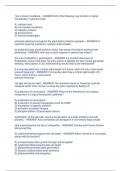
-
Biology Campbell Chapter 39 Test Bank Latest solutions
- Exam (elaborations) • 12 pages • 2023
-
- $9.99
- + learn more
Biology Campbell Chapter 39 Test Bank Non-random mutations. - ANSWER All of the following may function in signal transduction in plants except A.) calcium ions. B) non-random mutations. C) receptor proteins. D) phytochrome. E) second messengers. activates defences throughout the plant before infection spreads. - ANSWER In systemic acquired resistance, salicylic acid probably by producing heat-shock proteins, which may protect the plants’ proteins from denaturing - ANSWER How may...

-
SAT Biology Subject Test Hard Practice Questions and Answers
- Exam (elaborations) • 6 pages • 2023
- Available in package deal
-
- $7.99
- + learn more
SAT Biology Subject Test Hard Practice Questions All of the following contribute to variation in a population EXCEPT A) Mutation B) Isolation C) Sexual Reproduction D) Conjugation E) Genetic Drift - B) Isolation Conjugation is a primitive form of sexual reproduction carried out by bacteria and algae. If a population is isolated, there can be no flow of genetic material. Oxygen released by plants comes from A) Air B) Carbon dioxide C) Glucose D) Chlorophyll E) Water - E) Water D...
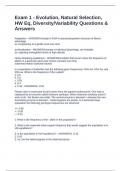
-
Exam 1 - Evolution, Natural Selection, HW Eq, Diversity/Variability Questions & Answers
- Exam (elaborations) • 11 pages • 2024
-
- $12.99
- + learn more
Adaptation - ANSWERSchange in DNA in species/population because of fitness advantage ex: lengthening of a giraffe neck over time acclimatization - ANSWERSchange in individual physiology, not heritable ex: adjusting hemoglobin levels at high altitude Hardy-Weinberg equilibrium - ANSWERScondition that occurs when the frequency of alleles in a particular gene pool remain constant over time (observed match expected values) In a population of butterflies has the following gene frequencies...
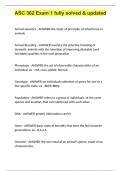
-
ASC 362 Exam 1 fully solved & updated
- Exam (elaborations) • 13 pages • 2024
- Available in package deal
-
- $7.99
- + learn more
Animal Genetics - ANSWER-the study of principles of inheritance in animals Animal Breeding - ANSWER-involves the selective breeding of domestic animals with the intention of improving desirable (and heritable) qualities in the next generation Phenotype - ANSWER-the set of observable characteristics of an individual; ex - red, roan, polled, horned Genotype - ANSWER-an individuals collection of genes for one or a few specific traits; ex - BbPP, BBPp Population - ANSWER-refers to a grou...
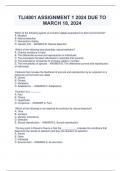
-
TLI4801 ASSIGNMENT 1 2024 DUE TO MARCH 18, 2024
- Exam (elaborations) • 18 pages • 2024
-
- $13.49
- + learn more
TLI4801 ASSIGNMENT 1 2024 DUE TO MARCH 18, 2024 Which of the following agents of evolution adapts populations to their environments? A. Mutation B. Natural selection C. Nonrandom mating D. Genetic drift - ANSWER B. Natural Selection Which of the following best describes natural selection? A. Chance variations in traits B. The differential survival and reproduction of individuals C. The processes that lead individuals to resemble their parents D. The potential for all species to incre...
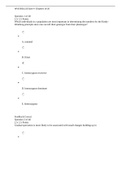
-
APUS BIOL133 Exam 4- Chapters 16-20.
- Exam (elaborations) • 29 pages • 2022
-
- $8.49
- + learn more
APUS BIOL133 Exam 4- Chapters 16-20 Question 1 of 40 2.5/ 2.5 Points Which individuals in a population are most important in determining the numbers for the HardyWeinberg principle since one can tell their genotype from their phenotype? A. mutated B. fittest C. homozygous recessive D. homozygous dominant E. heterozygous Feedback:Correct Question 2 of 40 2.5/ 2.5 Points Gradual speciation is more likely to be associated with small changes building up in ...
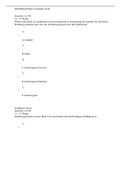
-
APUS BIOL133 Exam 4- Chapters 16-20.
- Exam (elaborations) • 29 pages • 2022
-
- $15.39
- + learn more
Question 1 of 40 2.5 / 2.5 Points Which individuals in a population are most important in determining the numbers for the Hardy- Weinberg principle since one can tell their genotype from their phenotype? • A. mutated • B. fittest • C. homozygous recessive • D. homozygous dominant • E. heterozygous Feedback:Correct Question 2 of 40 2.5 / 2.5 Points Gradual speciation is more likely to be associated with small changes building up in • ...
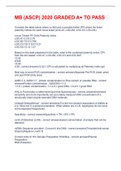
-
MB (ASCP) 2020 GRADED A+ TO PASS
- Exam (elaborations) • 39 pages • 2022
- Available in package deal
-
- $15.49
- + learn more
MB (ASCP) 2020 GRADED A+ TO PASSConsider the table below where a child and a possible father (PF) share the listed paternity indices for each locus listed (LOC-A1, LOC-B2, LOC-C3, LOC-D4). Locus Tested PF Child Paternity Index LOC-A1 3 2/3 2.18 LOC-B2 7/5 5 0.798 LOC-C3 15/17 9/17 5.21 LOC-D.37 Based on the data presented in the table, what is the combined paternity index, CPI, from the loci tested: LOC-A1, LOC-B2, LOC-C3 and LOC-D4? 12.42 9.558 15.56 2.38 12.42 ( CPI is calculate...
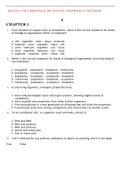
-
biology-essentials-3rd-hoefnagels-test-bank
- Exam (elaborations) • 43 pages • 2022
-
- $7.99
- + learn more
Detailed Contents UNIT 1 Science, Chemistry, and Cells Chapter 1 The Scientific Study of Life 1.1 What Is Life? A. Life Is Organized B. Life Requires Energy C. Life Maintains Internal Constancy D. Life Reproduces, Grows, and Develops E. Life Evolves 1.2 The Tree of Life Includes Three Main Branches 1.3 Scientists Study the Natural World A. The Scientific Method Has Multiple Interrelated Parts B. An Experimental Design Is a Careful Plan C. Theories Are Comprehensive Explanations D. ...

That summary you just bought made someone very happy. Also get paid weekly? Sell your study resources on Stuvia! Discover all about earning on Stuvia


